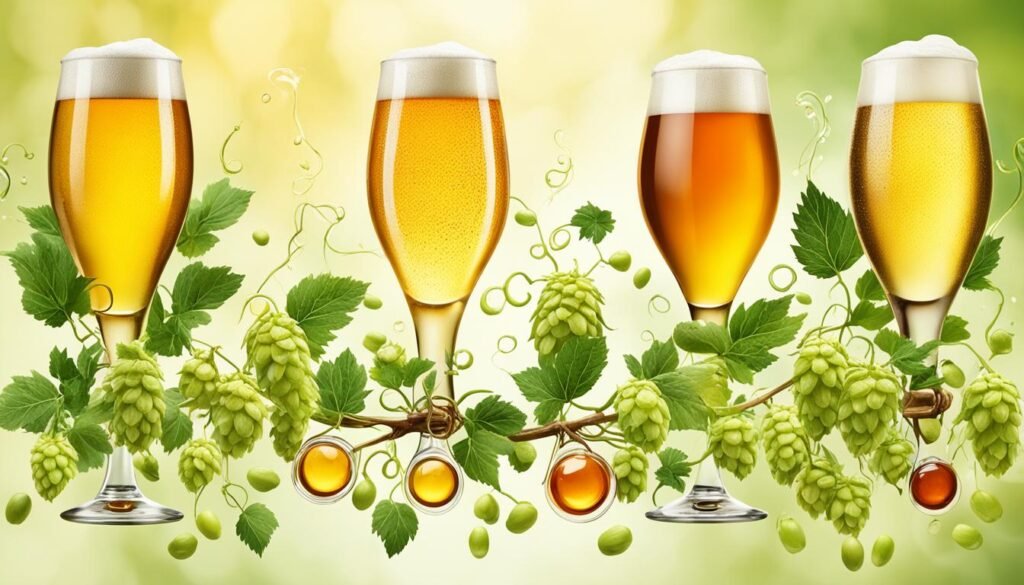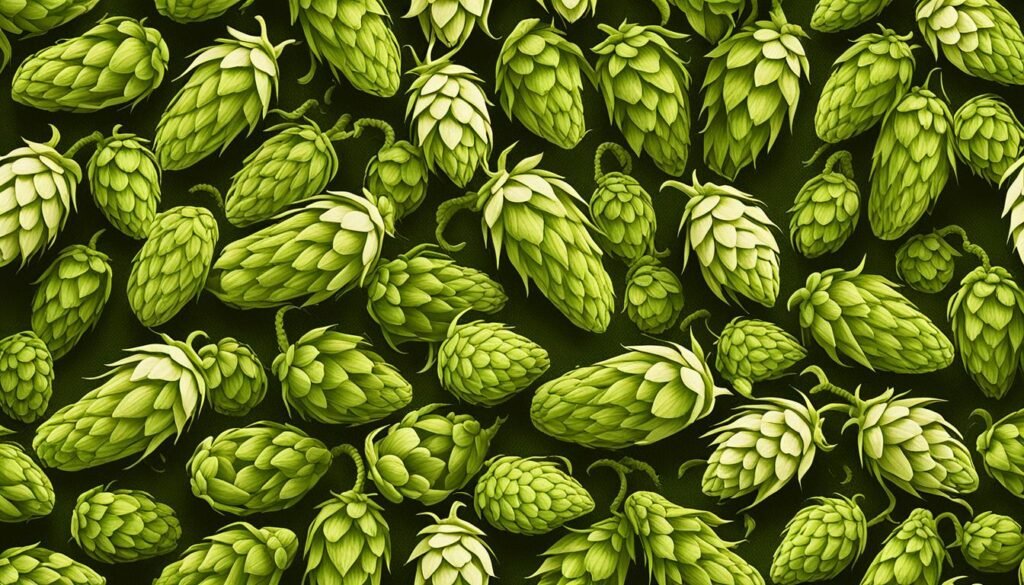Delving into the heart of craft brewing reveals a symphony of components that culminate in the creation of one of the world’s oldest and most beloved beverages. Central to this process are the main ingredients in beer: a quintet that shapes its very essence. These beer making ingredients – ranging from the foundational grains that form its body to the hops that impart a signature bitterness, from the industrious yeast that breathes life into each batch to the water that merges them all – are the building blocks of every pint we cherish. As we explore the complexities of each element in this brewing odyssey, one begins to appreciate the nuances and delicate chemistry that transform these beer recipe ingredients into fine ales and lagers savored across the globe.
Key Takeaways
- The fundamental ingredients of beer are grains, hops, yeast, and water.
- Each ingredient contributes uniquely to beer’s flavor, aroma, and appearance.
- Malted barley is the most common grain used, providing fermentable sugars and influencing color and taste.
- Hops offer bitterness to balance the sweetness of the malt, and add distinct flavors and aromas.
- Yeast is the catalyst for fermentation, turning sugars into alcohol and creating diverse beer styles.
- The mineral content of water has a significant impact on the final taste of the beer.
- Understanding these ingredients is crucial for both appreciating and crafting quality beer.
Uncovering the Essential Elements of Beer Crafting
Exploring the complex world of beer brewing unveils a rich tapestry woven from essential brewing ingredients. Integral to its creation are the 5 main ingredients in beer, each contributing unique qualities that culminate in the beloved beverage’s diverse flavor profile. Let’s delve deeper into the components that are pivotal in the beer crafting process.
A Deeper Look into Malted Grains and Their Impact on Beer
At the heart of the brewing process is malted barley, the canvas onto which beer’s rich flavors and colors are painted. Through malting, barley is transformed, activating enzymes that convert complex starch into maltose, a fermentable sugar that fuels yeast during the fermentation process. This biochemical reaction not only affects the beer’s strength but also imbues it with sweet, caramel notes or a robust, toasty essence, depending on the malt’s properties.
The Bitter and Aromatic World of Hops in Brewmaking
Contrasting the sweetness of malt are hops, the fragrant flowers that offer bitterness and an array of aromas to beer. Hops are the guardians of beer, providing antibacterial properties that ensure stability. The essential oils within the hops infuse the beer with everything from a citrusy zest to a piney sharpness, becoming a signature of individual brews and leaving an indelible mark on the taste buds of connoisseurs.
Fermentation Stars: Top and Bottom Fermenting Yeast Strains
The alchemical conversion of sugars into alcohol is the domain of yeast, the unsung heroes of brewing ingredients. The unique strains ‘Saccharomyces pastorianus’ and ‘Saccharomyces cerevisiae’ are respectively responsible for the crisp profile of lagers and the fruity warmth of ales, emphasizing the importance of yeast in defining beer varieties.
The Underrated Contributor: Water’s Role in Brewing
Often overlooked, water is not just a solvent in brewing but a shaper of destinies. The mineral content of local water sources has historically influenced region-specific beer styles, such as stouts and pale ales. What are the 5 main ingredients in beer without the crystalline essence of water? It is the foundation upon which all brewing artistry is built, impacting mouthfeel and acting as the medium for a symphony of flavors.
| Ingredient | Role in Beer | Contribution to Flavor |
|---|---|---|
| Malted Grains | Fermentable Sugars | Sweetness, Color, Body |
| Hops | Bitterness & Aroma | From Citrus to Herbal Notes |
| Yeast | Alcohol & Carbonation | Fruity to Bread-like Profiles |
| Water | Solvent & Flavor Influencer | Mineral Content Defines Style |
What are the 5 main ingredients in beer?

Discovering the essence of what beer is made of requires delving into the fundamental components that have remained consistent throughout the brewing history. Water, hops, yeast, and grains are the four classic beer ingredients, each with a critical role in the final product’s taste and character. Specialty beers often integrate a fifth element, such as corn, oats, or rice, to further expand the beverage’s complexity and flavor profile.
- Water: the unsung hero of beer, making up to 95% of its content.
- Hops: the source of bitterness and aromatic qualities that define a brew’s profile.
- Yeast: the catalyst that turns sugars into alcohol, without which there is no beer.
- Barley: the most common grain that provides the sugars necessary for fermentation and the core “malt” flavor.
- Other Grains and Adjuncts: like wheat, corn, and oats, which are used to alter the beer’s body, flavor, and texture.
With each of these beer ingredients imparting distinctive qualities, it’s no wonder that the craft of brewing has stood the test of time. Below is a table illustrating the unique contribution of each of these constituents:
| Ingredient | Role in Beer | Characteristic Impact |
|---|---|---|
| Water | Base liquid | Affects taste; mineral content can enhance or diminish certain flavor profiles. |
| Hops | Bittering, flavor and preservation | Adds bitterness to balance sweetness; provides floral, fruity, or earthy aromas. |
| Yeast | Fermentation | Produces alcohol; contributes to flavor and aroma; different strains can greatly alter the beer style. |
| Barley | Sugars for fermentation and malt flavor | Imparts sweet, toasty, and caramel notes; influences color and alcohol content. |
| Adjuncts (Wheat, Corn, Oats) | Modify body, flavor, texture | Can introduce creaminess, lighten texture, or provide a unique twist to traditional recipes. |
As the versatility of the beer ingredients merges with the ingenuity of brewers, the array of styles and tastes that can be achieved is boundless. Each of “What are the 5 main ingredients in beer?” offers something indispensable, while the subtle nuances of how they are integrated and the proportions in which they are used can yield a vast spectrum of beer experiences.
From Grain to Glass: The Malting Process and Its Effects
Exploring the essential brewing ingredients, malting stands out as a pivotal process in beer production. The transformation from grain to a formidable beverage starts here, where simple cereal grains are converted into the powerhouse of brewing: maltose. This sugar is the yeast’s fuel, fermenting into the alcohol and carbon dioxide that gives beer its soul.
Understanding Maltose: The Yeast’s Fuel for Alcohol Production
Maltose formation is a cornerstone in the beer making ingredients lineup. It occurs when enzymes, activated during the malting phase, break down the grain’s starches. Without this sugar, yeast would be devoid of its primary energy source, leaving us with a non-alcoholic grain soup rather than the complex brews we cherish.
Malt Varieties and the Palette of Flavors They Create
Beer’s diverse spectrum is largely owed to the range of malt types utilized by brewers. Each grain choice and malting technique imbues the final product with a unique profile. Below is a comparison table that illustrates the impact of different malts on the flavor and color of beer, evidencing how crucial brewing ingredients are to the beer-making artistry.
| Malt Variety | Color | Flavor Profile | Common Beer Types |
|---|---|---|---|
| Pale Malt | Light | Biscuit, Lightly Toasted | Pale Ale, IPA |
| Caramel/Crystal Malt | Amber to Dark Red | Sweet, Caramel, Toffee | Amber Ale, Red Ale |
| Chocolate Malt | Dark Brown to Black | Chocolate, Coffee, Roast | Stout, Porter |
The malting process unquestionably shapes the character of beer, setting the stage for brewers to craft an infinite array of ales and lagers. With such a variety of beer making ingredients at their disposal, the global tapestry of beer flavors continues to expand, offering enthusiasts an ever-growing field of tastes and experiences.
The Art of Bitterness and Aroma: A Dive into Hop Varieties

As we delve into the hop varieties that are quintessential beer recipe ingredients, we find a world rich with flavor and aroma, contributing to what are the 5 main ingredients in beer. The remarkable diversity in hop profiles allows brewers to imprint their signature on each batch, providing nuances that keep aficionados coming back for more.
Alpha Acids: The Chemistry Behind Beer’s Bitterness
The alpha acids present in hops are responsible for the bitterness that balances the sweet maltiness in beer. During the brewing process, these acids undergo isomerization, a transformation that occurs when hops are boiled, changing their chemical structure and resulting in that characteristic bitter taste beer lovers appreciate.
The Role of Hop Oils in Crafting Distinctive Beer Aromas
Hop oils are another vital component of beer recipe ingredients, offering an olfactory bouquet that can range from earthy and piney to fruity and floral. They are extracted during the brewing process and contribute significantly to the beer’s final aromatic profile, influencing its style and drinker’s perception even before the first sip is taken.
Exploring the Effects of Boiling Time on Hop Characteristics
Boiling hops for various durations impacts the intensity of bitterness and the level of aromatic oils that remain. Hop additions later in the boil cycle, or even post-boil during a technique called ‘dry hopping,’ can enhance aroma without significantly affecting bitterness. Each technique is a tool in the brewer’s kit, aiding in the fine-tuning of their craft.
| Hop Variety | Alpha Acid % | Common Aroma Profile | Typical Use |
|---|---|---|---|
| Cascade | 5-7% | Citrus, Floral | American Pale Ales |
| Fuggle | 4-5.5% | Earthy, Woody | English-style Ales |
| Saaz | 3-4.5% | Spicy, Herbal | Pilsners |
| Galaxy | 13-15% | Passionfruit, Citrus | IPA, Pale Ale |
Incorporating different hop varieties into a brew not only contributes to its bitterness and aroma but also aids in the preservation of the beer itself. The antimicrobial properties inherent to hops have been prized since their discovery, playing a role in maintaining beer quality over time. Ultimately, choosing hops is an artful balance of science, experience, and exploration.
Conclusion
Delving into the world of craft brewing reveals the profound complexity and versatility that the main ingredients in beer can offer. It is evident that the alchemy of combining just a few fundamental elements—grains, hops, yeast, and water—can result in such a varied spectrum of sensory experiences. This voyage from raw beer ingredients to the final ambrosial elixir showcases the ingenuity and resourcefulness of brewers who, with just the basics at their fingertips, can craft liquid artistry.
Each of these foundational substances holds its own magic. Grains offer the sweetness and color, hops provide the bitterness and aromatic nuance, yeast is the agent of transformation, and water, the unsung hero, sets the tone for it all. But beneath this simplicity lies the canvas for endless experimentation. The addition of various spices, fruits, and innovative brewing techniques allows for a dynamic brewing landscape where traditional rules are revisited and new flavors are born, catering to an ever-expanding audience of beer aficionados.
Ultimately, the main ingredients in beer serve as a testament to the refined sophistication that can be achieved through the careful balance and interplay of these simple, natural elements. Embraced by both the novice homebrewer and the seasoned craft beer connoisseur, they forge a common language, rich in history and alive with possibility. It’s this timeless dance of creativity and science that continues to challenge and inspire brewers around the globe, fueling an evolving culture of beer appreciation and innovation.
